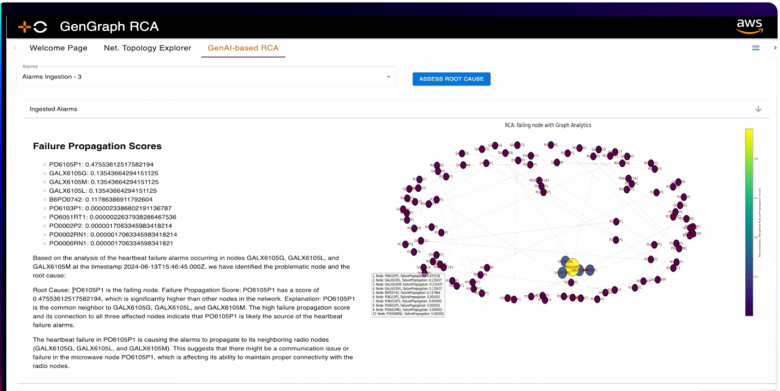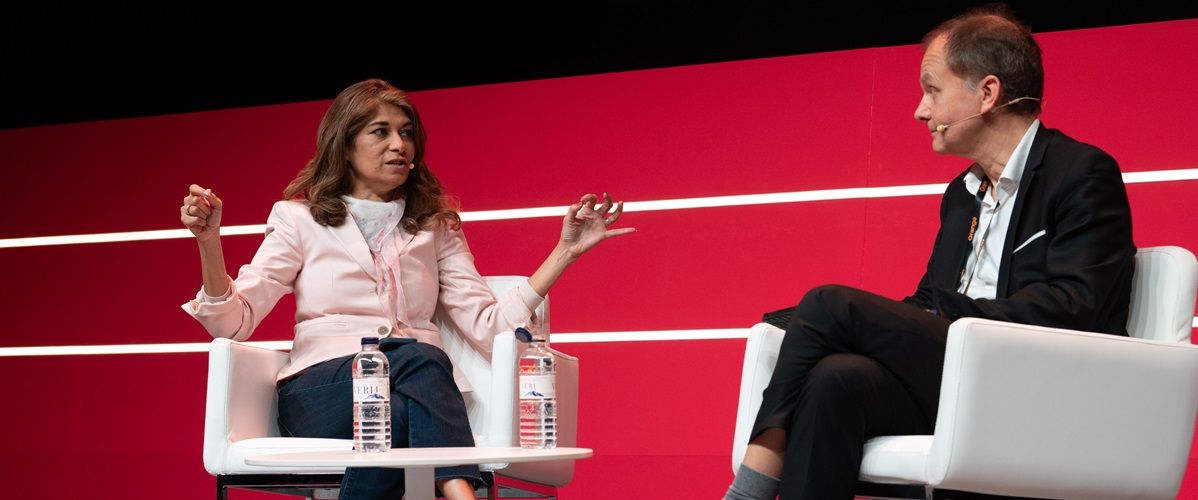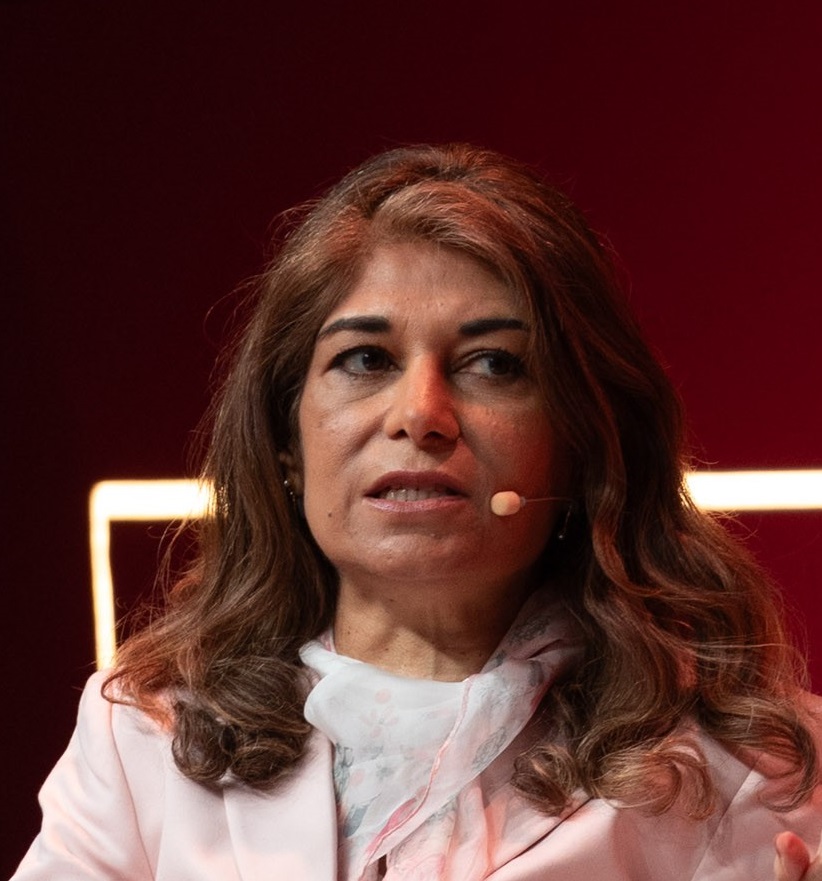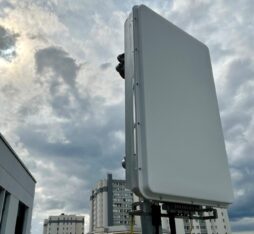• Examples of initiatives that help telecommunications companies optimize their operations include a network generative AI assistant for enhanced network observability and an AWS framework featuring a generative AI-augmented digital twin as a graph.
• Another example, a digital healthcare assistant in Senegal, shows how telecommunications companies can also leverage AI to create meaningful impact across diverse geographical and socioeconomic contexts, ultimately helping to bridge the digital divide.
Note from the Authors: At Mobile World Congress Barcelona 2025, the GSMA hosted a generative AI summit featuring industry leaders across the globe including McKinsey, NVIDIA, and others. In our jointly-hosted fireside chat, we had the chance to talk about a unique symbiosis of telecom and cloud that we coined Networks for AI, AI for Networks: our joint vision for enabling the AI Futures. However, it felt as if we’re just starting to scratch the surface. There’s so much more that we must partake in together to reimagine the network for it to unlock the transformative potential of AI, drive innovation, and expand digital inclusivity on a global scale with the power of this formidable duo.
Introduction
The fusion of AI and Networks is no longer a future prospect: it’s already reshaping the entire telecom industry landscape. As networks become the essential foundation for deploying and scaling AI applications globally, AI simultaneously transforms how networks are designed, operated, and optimized. This two-way relationship amplifies both technologies: networks provide the critical infrastructure needed for distributed AI deployments at scale, while AI revolutionizes network operations through automated optimization, predictive maintenance, and intelligent resource management. Through collaboration between AWS and Orange, we’re witnessing this dual transformation firsthand, where enhanced network capabilities enable broader AI adoption, and AI-driven innovations deliver more resilient, efficient networks.
This distributed architecture ensures that AI resources can be optimally allocated based on crucial parameters such as latency, data residency, and cost considerations.
AI for Networks
In our joint innovation journey, we’ve witnessed firsthand how AI transforms network operations through three crucial pillars: speed, scale, and security. A prime example is GenGraph Root Cause Analysis (RCA), where we tested this intelligent system with MasOrange in Spain. GenGraph RCA leverages dynamic topology discovery, graph analytics, generative AI, and agents for advanced root cause analysis. This collaboration has delivered the following benefits:
- Reduced complexity: Automated consolidation of thousands of network alarms into clear, actionable reports, eliminating noise and pinpointing critical issues.
- Accelerated resolution: Dramatic reduction in diagnostic time from over seven hours to mere seconds, enabling near real-time response to network issues.
- Enhanced visibility: Unified end-to-end network visualization across multiple vendors, replacing fragmented views with comprehensive, data-driven insights.

Figure 1: Root Cause Identification with graphs (Amazon Neptune), generative AI and agents (Amazon Bedrock)
We’ve expanded our collaboration further to develop a network generative AI assistant for enhanced network observability. This AI assistant, tested with Global Network Operations in Europe, specifically addresses Radio Access Network (RAN) troubleshooting challenges. Traditionally, network operations teams face significant complexity: they must navigate multiple disparate data sources, understand various database structures, and master multiple query languages to access network and service data. Our generative AI assistant eliminates these barriers by creating a unified, intuitive interface. Analyzing performance management (PM) data, fault management (FM) metrics, and historical trouble tickets allows the assistant to provide intelligent network status qualification and recommended actions based on Network Operations Center (NOC) queries. This streamlined approach allows operational teams to focus on problem-solving rather than data navigation, significantly improving efficiency and reducing resolution times. To learn more about the underlying integration of graph databases with Amazon Neptune and Amazon Bedrock, you can visit: Building GraphRAG Solutions Using Amazon Bedrock Knowledge Bases and Amazon Neptune Analytics.
Each of these initiatives demonstrates how AI can dramatically improve network operations while maintaining robust security protocols and enabling unprecedented scalability. As we continue co-imagining the future of AI and networks, we fundamentally believe that the resulting innovations will be multi-sector, multi-national, and multi-modal. This will create transformative impacts across industries and geographies using agentic AI flows.
Networks for AI
Although AI is revolutionizing network operations, the inverse relationship is equally critical: networks are becoming the fundamental enabler for AI deployment at scale. Central to this symbiosis is the need for a robust AI framework that supports diverse deployment models. Implementing a logically centralized yet physically distributed architecture, with an inherently secured control plane, allows organizations to achieve the same pillars of speed, scale, and security from a different angle. This architectural approach makes sure that AI applications can be deployed rapidly, scaled efficiently across geographical boundaries, and operated securely across the entire network infrastructure.
The true power of our ‘Networks for AI’ vision materializes most prominently in our strategic collaboration to democratize AWS Cloud access across emerging markets. Earlier last year at GITEX Africa, we announced plans to bring AWS Wavelength to Morocco and Senegal, enabling AWS users to support use cases across regulated industries that need data to remain local, such as telecom, finance, public sector, and healthcare, as well as industries that depend on low-latency applications such as gaming. Less than 12 months later, the Casablanca and Dakar AWS Wavelength Zones are generally available to users across the globe.
This initiative transcends mere infrastructure expansion. We aim to evolve it to a distributed intelligence plane that serves local innovation needs with global-grade capabilities. The foundation of this architecture rests on our Amazon Virtual Private Cloud (Amazon VPC) technology, which underpins every AI workload in the cloud, enabling seamless deployment across various compute locations, from foundation models in Amazon Bedrock to self-hosted language models in AWS Local Zones, AWS Outposts, or AWS Wavelength Zones. This distributed architecture makes sure that AI resources can be optimally allocated based on crucial parameters such as latency, data residency, and cost considerations.
A compelling illustration of this approach’s impact is visible in Senegal, where a local global systems integrator (GSI) is now developing a generative AI solution for a digital healthcare assistant, available both in French and Wolof, using accelerated compute instance types available on Amazon Elastic Compute Cloud (Amazon EC2) in AWS Wavelength within Orange’s network infrastructure. Deploying small language models (SLM) on scalable, cost-effective compute in these emerging markets exemplifies our commitment to digitally inclusive innovation. Embedding AWS compute directly within Orange’s network allowed us to create a globally distributed yet locally aware intelligence framework that maintains our core pillars of speed, scale, and security while adapting to specific regional needs. To learn more about how Networks could be underpinning generative AI applications at-scale, check out Building generative AI applications with on-premises and edge data or visit the hands-on workshop specifically designed for AWS Wavelength: Hands-on with Generative AI on AWS Hybrid & Edge Services.
Conclusion
The convergence of AI and networks represents a transformative frontier in telecom that extends far beyond technical innovation. This symbiotic relationship, where networks enable AI deployment and AI enhances network capabilities, creates a powerful evolution continuum that drives both technological advancement and social impact. From reducing network repair times to minutes instead of hours through GenGraph RCA, to democratizing AI access to the cloud across emerging markets, this collaboration demonstrates how the intersection of AI and networking can simultaneously advance technological capabilities while expanding digital inclusion. As we look ahead, this partnership sets a compelling blueprint for how telecom companies can use AI to not only optimize their operations but also create meaningful impact across diverse geographical and socioeconomic contexts. Ultimately, this helps bridge the digital divide while pushing the boundaries of what’s possible in network operations and AI deployment.
Acknowledgments
We would like to extend our sincere gratitude to the numerous teams and individuals at both AWS and Orange who contributed to the initiatives and innovations described in this post. Their collective expertise and dedication were instrumental in bringing these transformative solutions to life.













